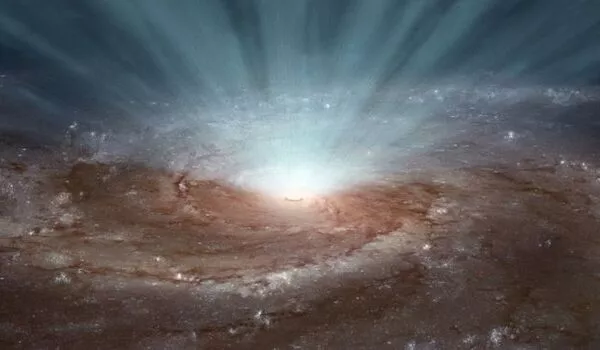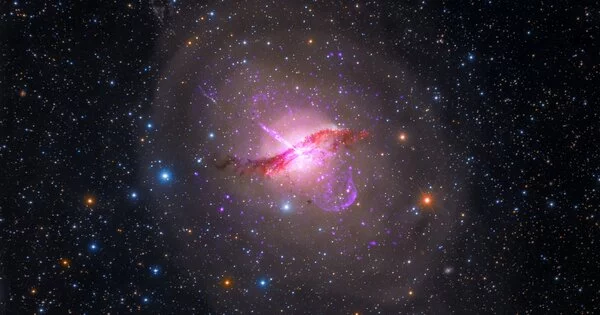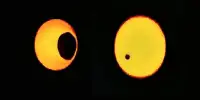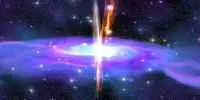Researchers have proposed the first feasible explanation for why one of the most massive black hole pairs ever seen by gravitational waves appeared to combine on a non-circular orbit. Their proposed solution, which has now been published in Nature, includes a chaotic triple drama inside a large disk of gas surrounding a super enormous black hole in a galaxy far, far away.
Black holes are one of the most fascinating objects in the Universe, but our understanding of them is still limited, owing to the fact that they do not emit light. Up until a few years ago, light was our main source of knowledge about our universe and its black holes, until the Laser Interferometer Gravitational Wave Observatory (LIGO) in 2015 made its breakthrough observation of gravitational waves from the merger of two black holes.
“But how and where do such black holes arise and merge in our Universe? Is it caused by neighboring stars collapsing and turning into black holes, by chance interactions in star clusters, or by something else? These are some of the most important topics in the new era of gravitational wave astronomy “Assist. Prof. Johan Samsing of the Niels Bohr Institute at the University of Copenhagen, the paper’s primary author, states
He and his colleagues may have now added a new component to the puzzle, potentially solving the final piece of a problem that astrophysicists have been grappling with for some years.
This is due to the fundamental nature of the gravitational waves emitted, which not only brings the pair of black holes closer for them to eventually merge but also acts to circularize their orbit.
Professor Zoltan Haiman
Unexpected Discovery in 2019
The mystery dates back to 2019, when the LIGO and Virgo observatories made an unexpected detection of gravitational waves. The event known as GW190521 is assumed to represent the merger of two black holes that were not only heavier than previously thought physically feasible, but also created a burst of light.
Possible explanations for these two traits have subsequently been proposed, but gravitational waves also revealed a third astounding feature of this event: the black holes did not orbit each other in a circle in the seconds before merging.
“The gravitational wave event GW190521 is the most surprising discovery to date. The black holes’ masses and spins were already surprising, but even more surprising was that they appeared not to have a circular orbit leading up to the merger,” says co-author Imre Bartos, Prof. at the University of Florida.
But why is a non-circular orbit so unusual and unexpected?
“This is due to the fundamental nature of the gravitational waves emitted, which not only brings the pair of black holes closer for them to eventually merge but also acts to circularize their orbit,” says co-author and Columbia University Professor Zoltan Haiman.
Many people throughout the world, including Johan Samsing in Copenhagen, were perplexed by this observation. “It made me start thinking about how such non-circular (known as “eccentric”) mergers might happen with the shockingly high likelihood as the study shows,” explains Johan Samsing.
It Takes Three to Tango
A possible answer would be found in the harsh environment in the centers of galaxies harboring a giant black hole millions of times the mass of the Sun surrounded by a flat, rotating disk of gas.
“In these environments the typical velocity and density of black holes is so high that smaller black holes bounce around as in a giant game of billiards and wide circular binaries cannot exist,” points out co-author Prof. Bence Kocsis from the University of Oxford.
However, as the researchers went on to argue, a massive black hole is insufficient “According to new research, the gas disk plays a crucial role in catching smaller black holes, which migrate closer to the center and also closer to one another over time. This indicates that they not only meet and form couples, but that such a pair may interact with another, third, black hole, often resulting in a chaotic dance with three black holes floating around “explains co-author and astrophysicist Hiromichi Tagawa of Tohoku University.
However, all previous research prior to the discovery of GW190521 showed that the formation of eccentric black hole mergers is extremely uncommon. This automatically prompts the question: Why did the already unusual gravitational wave source GW190521 also merge on an eccentric orbit?

Two Dimensional Black Hole Billiards
Everything that has been estimated thus far has been based on the assumption that black hole interactions occur in three dimensions, as expected in the bulk of star systems studied thus far.
“But then we wondered what would happen if the black hole interactions took place in a flat disk, which is closer to a two-dimensional environment. Surprisingly, we discovered that in this limit, the likelihood of producing an eccentric merger jumps by up to a hundred times, implying that almost half of all black hole mergers in such disks may be eccentric “Johan Samsing goes on to say:
“And that discovery matches amazingly well with the observation in 2019, which all indicates in the direction that the otherwise outstanding attributes of this source are not that weird again, assuming it was generated in a flat gas disk surrounding a super huge black hole in a galactic nucleus.”
This probable answer also contributes to a century-old problem in mechanics “The interaction of three things is one of the oldest problems in physics, and it has been extensively explored by Newton, myself, and others. It’s remarkable that this now appears to play a critical part in how black holes merge in some of our Universe’s most extreme locations “Nathan W. Leigh, Professor at the Universidad de Concepción in Chile, is a co-author.
Black Holes in Gaseous Disks
The gas disk theory also accords with other researchers’ explanations for GW190521’s other two perplexing features. The huge masses of the black hole were achieved through successive mergers within the disk, whereas light emission could be caused by surrounding gas.
“We have now shown that there can be a huge difference in the signals emitted from black holes that merge in flat, two-dimensional disks versus those we often consider in three-dimensional stellar systems, which tells us that we now have an extra tool that we can use to learn about how black holes are created and merge in our Universe,” says Johan Samsing.














